I have this dataset with 4 key features and the aim is to plot them in a single plot so I can analyze them simultaneously but I couldn't be able to achieve the goal. Can please someone guide me?
Sample Data:
dput(head(Mafraq.spi, 30))
structure(list(year = c(1985, 1986, 1986, 1986, 1986, 1986, 1986,
1986, 1986, 1986, 1986, 1986, 1986, 1987, 1987, 1987, 1987, 1987,
1987, 1987, 1987, 1987, 1987, 1987, 1987, 1988, 1988, 1988, 1988,
1988), `SPI 3` = c(1.03, 1.84, 0.06, -0.48, -0.05, 1.4, 1.4,
0.74, 2.69, 1.79, 1.3, -0.59, -1.11, -1.14, -2.89, -1.4, -0.38,
1.4, 1.4, 2.17, 0.67, 0.71, 0.03, -0.01, -0.02, 0.26, 0.69, 0.33,
-0.38, 1.4), `SPI 6` = c(0.32, 0.24, 0.52, 0.91, 1.8, 0.05, -0.53,
0.46, 2.68, 1.78, 1.29, 1.28, 0.87, 0.67, -1.53, -1.83, -1.33,
-2.9, -1.4, 1.89, 0.66, 0.7, 0.46, 0.19, 0.38, 0.05, 0.21, -0.09,
0.11, 0.68), `SPI 9` = c(0.32, 0.17, 0.15, 0.15, 0.21, 0.52,
0.9, 1.87, 2.63, 1.76, 1.28, 1.27, 0.86, 0.7, 0.65, 0.65, 0.61,
-1.54, -1.87, -0.32, -1.08, 0.38, 0.39, 0.19, 0.37, 0.41, 0.35,
0.35, -0.02, 0.21), `SPI 12` = c(0.24, 0.14, 0.15, 0.15, 0.15,
0.15, 0.15, 0.27, 1.91, 1.93, 1.87, 1.19, 0.75, 0.69, 0.64, 0.64,
0.64, 0.64, 0.65, 0.94, -1.1, -0.62, -0.23, -0.54, 0.15, 0.35,
0.34, 0.34, 0.34, 0.34)), row.names = c(NA, -30L), class = c("tbl_df",
"tbl", "data.frame"), na.action = structure(1:11, names = c("1",
"2", "3", "4", "5", "6", "7", "8", "9", "10", "11"), class = "omit"))
Code:
library(dplyr)
Mafraq.spi <- na.omit(read_excel("K:/talha.R/Project 56/Mafraq-his-SPI-SPEI.xlsx", sheet = "SPI"))
selected_vars <- c("year", "SPI 3", "SPI 6", "SPI 9", "SPI 12")
Mafraq.spi <- Mafraq.spi %>%
select(all_of(selected_vars)) %>%
mutate(year = as.Date(paste0(year, "-01-01")))
ggplot(Mafraq.spi, aes(x = year)) +
geom_line(aes(y = `SPI 12`, color = "SPI 12")) +
geom_line(aes(y = `SPI 9`, color = "SPI 9")) +
geom_line(aes(y = `SPI 6`, color = "SPI 6")) +
geom_line(aes(y = `SPI 3`, color = "SPI 3")) +
labs(x = "Year", y = "Value", color = "Variable") +
scale_color_manual(values = c("SPI 12" = "blue", "SPI 9" = "red", "SPI 6" = "green", "SPI 3" = "purple")) +
theme_minimal()
Fix with the help of @r2evans:
Mafraq.spi %>%
mutate(year = year + (row_number() - 1)/12) %>%
mutate(year = ifelse(year == 1985, 1985 + 11/12, year)) %>%
mutate(year = as.numeric(year)) %>%
pivot_longer(cols = starts_with("SPI"), names_to = "SPI", values_to = "value") %>%
ggplot(aes(year, value, color = SPI)) +
geom_line() +
facet_grid(SPI ~ .) +
scale_color_manual(values = c("SPI 12" = "blue", "SPI 9" = "red", "SPI 6" = "green", "SPI 3" = "purple")) +
theme_minimal()



